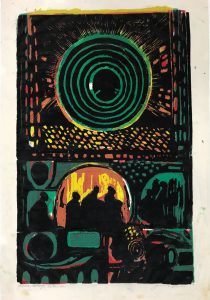 James Lesesne Wells (American, 1902-1993)
James Lesesne Wells (American, 1902-1993)
Bus Stop, Ghana, 1972
Color linoleum cut on thin Japan paper
Proof from ed. of 25
24 1/8 x 15 5/8 in.
Leepa-Rattner Museum of Art, St. Petersburg College, gift of James G. Sweeny in memory of Martha M. Sweeny, 2020.4.9
Born in 1902, in Atlanta, Georgia, James Lesesne Wells was a prolific printmaker and painter of the Harlem Renaissance. Considered a pioneer in modern art education, Wells was an influential art professor at Howard University, in Washington, D.C., where he taught ceramics, sculpture, metal and block printing from 1929 to 1968. An innovator in printmaking, he introduced linoleum block printing and white line engraving to the art department and mentored many young artists, including Elizabeth Catlett.
At a young age, Wells’ family moved to Florida, where at age 13, he won top awards in painting and woodworking at the Florida State Fair and attended Baptist Academy, in Jacksonville. He went on to study at Lincoln University, in Pennsylvania, and transferred to Columbia University in New York where earned a Bachelor’s degree in art education in 1925 and a Master’s degree in the 1960s. As a young artist and student at Columbia, he was embedded in the Harlem Renaissance as an illustrator for African American newspapers. He found inspiration from the Brooklyn Museum of Art’s African sculptures and the woodcuts of Albrecht Dürer and the German Expressionist Emile Nolde. Unlike most of his contemporaries, Wells viewed printmaking as a major artform.
During the Great Depression, Wells began to focus on making art more affordable through printmaking. Out of the WPA, he created lithographs, woodcuts and etchings of the African American experience and directed a summer art program in a Harlem nightclub with art assistants that included a young Jacob Lawrence. In 1933-34, Wells was completely devoted to printmaking as said, “Becoming aware of the social and economic conditions of the time and the awakening of the ‘New Negro,’ I felt that the graphic arts would lend itself readily to the projection of ideas about these issues.”
After World War II, Wells spent his teaching sabbatical from Howard University working in Stanley Hayter’s Atelier 17, in New York. As he continued to teach and create his art, he was also actively involved in the Civil Rights Movement of the 1960s by protesting segregation at lunch counters and fought for the hiring of Black police officers. Wells’ work is collected by major museums and in the 1980s, he was awarded the Presidential Citation for Lifelong Contribution to American Art by President Jimmy Carter.
An impression of Bus Stop, Ghana can also be found in the permanent collections of the Metropolitan Museum of Art and Yale University.
